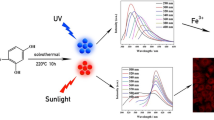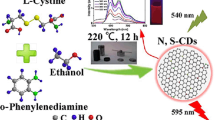Abstract
Carbon-based luminescent materials have attracted much attention of many researchers in recent years for its better optical properties and biological applications. In this paper, we report the full-color CDs (from blue to red) with better quality red emissive by a facile and efficient synthesis route. The CDs show multiple red-emission tuning, unique nature of up-conversion photoluminescent under lower excitation and single-particle photoluminescent. The luminescence mechanism was also explored preliminarily. Especially, the results demonstrate that full-color CDs with multiple red wavelength tuning were achieved successfully by using only one precursor and this phenomenon was reasonably explored by using solvatochromism mechanism instead of only excitation-dependent or emission tuning. Moreover, the multicolor FL emission of CDs is caused by single particles rather than a mixture with diverse photoluminescent, which can be expanded to precision manufacture field on luminance, but not just limited to multidimensions biosensing. In addition, UCPL under lower excitation implies the more important potential applications in surface layer bioimaging, microarray detection and light activation technology in vivo and in vitro. The full-color CDs show high quantum yield (73.89%) and superior anti-photobleaching. Multicolor bioimaging, in vitro and in vivo, indicates its low toxicity in Hela cells and zebrafish. Besides, the as-prepared CDs were successfully used for multidimensions sensing, as Fe3+ metal ion sensing (on/off).




Similar content being viewed by others
References
Sheila NB, Gary AB (2010) Lumineszierende Kohlenstoff-Nanopunkte: nanolichtquellen mit zukunft. Angew Chem Int Ed 122:6876–6896
Shin HJ, Clair S, Kim Y, Kawai M (2009) Substrate-induced array of quantum dots in a single-walled carbon nanotube. Nat Nanotechnol 4:567–570
Zhang J, Cheng F, Li J, Zhu JJ, Lu Y (2016) Fluorescent nanoprobes for sensing and imaging of metal ions: recent advances and future perspectives. Nano Today 11:309–329
Hildebrandt N, Spillmann CM, Algar WR et al (2017) Energy transfer with semiconductor quantum dot bioconjugates: a versatile platform for biosensing, energy harvesting, and other developing applications. Chem Rev 117:536–711
Leturcq R, Stampfer C, Inderbitzin K et al (2009) Franck–Condon blockade in suspended carbon nanotube quantum dots. Nat Phys 5:327–331
Wang Y, Hu R, Lin G, Roy I, Yong KT (2013) Functionalized quantum dots for biosensing and bioimaging and concerns on toxicity. ACS Appl Mater Interfaces 5:2786–2799
Xue Q, Zhang H, Zhu M et al (2017) Photoluminescent Ti3C2 MXene quantum dots for multicolor cellular imaging. Adv Mater 29:1604847–1604852
Hofmann MS, Glückert JT, Noé J, Bourjau C, Dehmel R, Högele A (2013) Bright, long-lived and coherent excitons in carbon nanotube quantum dots. Nat Nanotechnol 8:502–505
Das SK, Liu Y, Yeom S, Kim DY, Richards CI (2014) Single-particle fluorescence intensity fluctuations of carbon nanodots. Nano Lett 14:620–625
Qu S, Zhou D, Li D et al (2016) Toward efficient orange emissive carbon nanodots through conjugated sp(2)-domain controlling and surface charges engineering. Adv Mater 28:3516–3521
Liu Q, Guo BD, Rao ZY, Zhang BH, Gong JR (2013) Strong two-photon-induced fluorescence from photostable, biocompatible nitrogen-doped graphene quantum dots for cellular and deep-tissue imaging. Nano Lett 13:2436–2441
Lee J, Wong D, Velasco JJ et al (2016) Imaging electrostatically confined Dirac fermions in graphene quantum dots. Nat Phys 12:1032–1036
Dong YQ, Wang RX, Li H, Shao JW, Chi YW, Lin XM, Chen GN (2012) Polyamine-functionalized carbon quantum dots for chemical sensing. Carbon 50:2810–2815
Wang F, Liu X (2014) Multicolor tuning of lanthanide-doped nanoparticles by single wavelength excitation. Acc Chem Res 47:1378–1385
Liu R, Wu D, Liu S, Koynov K, Knoll W, Li Q (2009) An aqueous route to multicolor photoluminescent carbon dots using silica spheres as carriers. Angew Chem Int Ed 48:4598–4601
Hola K, Zhang Y, Wang Y, Giannelis EP, Zboril R, Rogach AL (2014) Carbon dots—emerging light emitters for bioimaging, cancer therapy and optoelectronics. Nano Today. 9:590–603
Stich MIJ, Schaeferling M, Wolfbeis OS (2009) Multicolor fluorescent and permeation-selective microbeads enable simultaneous sensing of pH, oxygen, and temperature. Adv Mater 21:2216–2220
Zhu S, Meng Q, Wang L et al (2013) Highly photoluminescent carbon dots for multicolor patterning, sensors, and bioimaging. Angew Chem Int Ed 52:4045–4049
Kalytchuk S, Polakova K, Wang Y, Froning JP, Cepe K, Rogach AL, Zboril R (2017) Carbon dot nanothermometry: intracellular photoluminescence lifetime thermal sensing. ACS Nano 11:1432–1442
Li W, Zhang Z, Kong B et al (2013) Simple and green synthesis of nitrogen-doped photoluminescent carbonaceous nanospheres for bioimaging. Angew Chem Int Ed 125:8309–8313
Chen D, Yang D, Dougherty CA et al (2017) In vivo targeting and positron emission tomography imaging of tumor with intrinsically radioactive metal-organic frameworks nanomaterials. ACS Nano 11:4315–4327
Lei Y, Tang J, Shi H et al (2016) Nature-inspired smart DNA nanodoctor for activatable in vivo cancer imaging and in situ drug release based on recognition-triggered assembly of split aptamer. Anal Chem 88:11699–11706
Zheng M, Liu S, Li J et al (2014) Integrating oxaliplatin with highly luminescent carbon dots: an unprecedented theranostic agent for personalized medicine. Adv Mater 26:3554–3560
Chen Q, Xu L, Liang C, Wang C, Peng R, Liu Z (2016) Photothermal therapy with immune-adjuvant nanoparticles together with checkpoint blockade for effective cancer immunotherapy. Nat Commun 7:13193–13202
Zhang SC, Kang LX, Wang X et al (2017) Arrays of horizontal carbon nanotubes of controlled chirality grown using designed catalysts. Nature 543:234–238
Dong Y, Pang H, Yang HB et al (2013) Carbon-based dots co-doped with nitrogen and sulfur for high quantum yield and excitation-independent emission. Angew Chem Int Ed 125:7954–7958
Pan LL, Sun S, Zhang A et al (2015) Truly fluorescent excitation-dependent carbon dots and their applications in multicolor cellular imaging and multidimensional sensing. Adv Mater 27:7782–7787
Alexander PD, Mariia OD (2016) The origin of emissive states of carbon nanoparticles derived from ensemble-averaged and single-molecular studies. Nanoscale 8:14057–14069
Alice S, Michela G, Gianpiero B et al (2018) Disentangling size effects and spectral inhomogeneity in carbon nanodots by ultrafast dynamical hole-burning. Nanoscale 10:15317–15323
Yu K, Lee JM, Kim J, Kim G et al (2014) Semiconducting polymers with nanocrystallites interconnected via boron-doped carbon nanotubes. Nano Lett 14:7100–7106
Jiang K, Sun S, Zhang L, Lu Y, Wu A, Cai C, Lin H (2015) Red, green, and blue luminescence by carbon dots: full-color emission tuning and multicolor cellular imaging. Angew Chem Int Ed 54:5360–5363
Sciortino A, Marino E, Dam B, Schall P, Cannas M, Messina F (2016) Solvatochromism unravels the emission mechanism of carbon nanodots. J Phys Chem Lett 7:3419–3423
Qu S, Liu XY, Guo XY, Chu MH, Zhang LG, Shen DZ (2014) Amplified spontaneous green emission and lasing emission from carbon nanoparticles. Adv Funct Mater 24:2689–2695
Qu S, Wang XY, Lu QP, Liu XY, Wang LJ (2012) A biocompatible fluorescent ink based on water-soluble luminescent carbon nanodots. Angew Chem Int Ed 51:12215–12218
Wang J, Wang CF, Chen S (2012) Amphiphilic egg-derived carbon dots: rapid plasma fabrication, pyrolysis process, and multicolor printing patterns. Angew Chem Int Ed 51:9297–9301
Dong YQ, Shao JW, Chen CQ, Li H, Wang RX, Chi YW, Lin XM, Chen GN (2012) Blue luminescent graphene quantum dots and graphene oxide prepared by tuning the carbonization degree of citric acid. Carbon 50:4738–4743
Kong B, Zhu A, Ding C, Zhao X, Li B, Tian Y (2012) Carbon dot-based inorganic–organic nanosystem for two-photon imaging and biosensing of pH variation in living cells and tissues. Adv Mater 24:5844–5848
Kwon OS, Park SJ, Lee JS et al (2012) Multidimensional conducting polymer nanotubes for ultrasensitive chemical nerve agent sensing. Nano Lett 12:2797–2802
Chen K, Shu Q, Schmittel M (2015) Design strategies for lab-on-a-molecule probes and orthogonal sensing. Chem Soc Rev 44:136–160
Xie SL, Bian WP, Wang C, Junaid M, Zou JX, Pei DS (2016) A novel technique based on in vitro oocyte injection to improve CRISPR/Cas9 gene editing in zebrafish. Sci Rep 6:34555–34564
Xu HB, Zhou SH, Xiao LL, Wang HH, Li SZ, Yuan QH (2015) Fabrication of a nitrogen-doped graphene quantum dot from MOF-derived porous carbon and its application for highly selective fluorescence detection of Fe3+. J Mater Chem C 3:291–297
Acknowledgements
This work was supported by research funding from the National Natural Science Foundation of China (Grant No. 61575196), Major Project of Science & Technology Department in Sichan Province (2016JY0168), Youth Innovation Promotion Association of CAS (2015316), the National High Technology Research and Development Program of China (863 Program 2015AA021107), Three Hundred Leading Talents in Scientific and Technological Innovation Program of Chongqing (No. CSTCCXLJRC201714 to D.S.P.).
Author information
Authors and Affiliations
Corresponding author
Ethics declarations
Conflict of interest
All authors declare that there is no conflict of interest.
Additional information
Publisher's Note
Springer Nature remains neutral with regard to jurisdictional claims in published maps and institutional affiliations.
Electronic supplementary material
Below is the link to the electronic supplementary material.
Rights and permissions
About this article
Cite this article
Huo, F., Liang, W., Tang, Y. et al. Full-color carbon dots with multiple red-emission tuning: on/off sensors, in vitro and in vivo multicolor bioimaging. J Mater Sci 54, 6815–6825 (2019). https://doi.org/10.1007/s10853-019-03370-6
Received:
Accepted:
Published:
Issue Date:
DOI: https://doi.org/10.1007/s10853-019-03370-6




